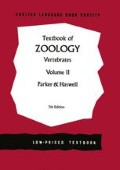Abstract
All mammals possess dermal milk-glands, and only mammals possess them. All mammals are at least partially hairy. A single dentary, articulating with the squamosal, occurs on each side in the lower jaw. The skull has a double occipital condyle. The brain, and particularly the forebrain, is relatively large. The vertebrae are gastrocentrous (Fig. 452). Each vertebra consists of a centrum and a neural arch and, in addition, thin plate-like disks of bone—the epiphyses—at each end. On the cessation of growth these fuse with the body of the vertebra. The tympanic membrane or eardrum is supported by a tympanic bone and there are three minute auditory ossicles (malleus, incus, and stapes) in the middle ear. A muscular diaphragm completely separates the thorax from the abdominal cavity. Excluding the Monotremata (p. 688) all mammals are viviparous, i.e. they produce their young alive. Most of them develop a filtering placenta between the maternal and embryonic tissues in the uterus and employ special means, both anatomical and behavioural, for the protection and nourishment of the newly bom young. Like the birds, they are homœ othermous with a four-chambered heart separating completely the oxygenated and deoxygenated blood. Birds and mammals are characterised also by the retention of a single aortic arch, in Mammalia the left one, in Aves the right.
Author information
Authors and Affiliations
Copyright information
© 1962 Macmillan & Co Ltd
About this chapter
Cite this chapter
Parker, T.J., Haswell, W.A. (1962). Class Mammalia. In: Textbook of Zoology Vertebrates. Palgrave, London. https://doi.org/10.1007/978-1-349-00198-9_13
Download citation
DOI: https://doi.org/10.1007/978-1-349-00198-9_13
Publisher Name: Palgrave, London
Print ISBN: 978-1-349-00200-9
Online ISBN: 978-1-349-00198-9
eBook Packages: Biomedical and Life SciencesBiomedical and Life Sciences (R0)

